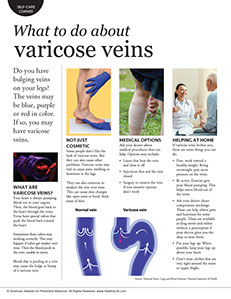SYMPTOM CHECKER
CONDITIONS
Male
Female
Child
Arm, Hand & Shoulder Concerns
Legs & Feet Concerns
Dental & Mouth Concerns
Ear & Nose
Eye Conditions
Head Conditions
Arm, Hand & Shoulder Concerns
Legs & Feet Concerns
Front
Back
Arm, Hand & Shoulder Concerns
Dental & Mouth Concerns
Ear & Nose
Eye Conditions
Head Conditions
Arm, Hand & Shoulder Concerns
Dental & Mouth Concerns
Ear & Nose
Eye Conditions
Head Conditions
Front
Back
Arm, Hand & Shoulder Concerns
Neck Links
Head & Neck Concerns
Arm, Hand & Shoulder Concerns
Neck Links
Head & Neck Concerns
Front
Back
Online Clinic
Wise Healthcare
What to do about varicose veins
Print on Demand
Do you have bulging veins on your legs? The veins may be blue, purple or red in color. If so, you may have varicose veins.
What are varicose veins?
Your heart is always pumping blood out to your organs. Then, the blood goes back to the heart through the veins. Veins have special valves that push the blood back toward the heart.
Sometimes these valves stop working correctly. This may happen if valves get weaker over time. Then the blood pools in the vein, unable to move. Blood that is pooling in a vein may cause the bulge or bump of a varicose vein.
Not just cosmetic
Some people don’t like the look of varicose veins. But they can also cause other problems. Varicose veins may itch or cause pain, swelling or heaviness in the legs.
They can also continue to weaken the vein over time. This can cause skin changes like open sores or hard, thick areas of skin.
Medical options
Ask your doctor about medical procedures that can help. Options may include:
• Lasers that heat the vein and close it off
• Injections that seal the vein closed
• Surgery to remove the vein if non-invasive options don’t work
Helping at home
If varicose veins bother you, there are some things you can do.
• First, work toward a healthy weight. Being overweight puts more pressure on the veins.
• Be active. Exercise gets your blood pumping. This helps move blood out of the veins.
• Ask your doctor about compression stockings. These can help relieve pain and heaviness for some people. These are available at drug stores and online without a prescription if your doctor gives you the okay to wear them.
• Put your legs up. When possible, keep your legs up above your heart.
• Don’t wear clothes that are very tight around the waist or upper thighs.
Source: National Heart, Lung and Blood Institute, National Institutes of Health
This website is not meant to substitute for expert medical advice or treatment. Follow your doctor’s or health care provider’s advice if it differs from what is given in this guide.
The American Institute for Preventive Medicine (AIPM) is not responsible for the availability or content of external sites, nor does AIPM endorse them. Also, it is the responsibility of the user to examine the copyright and licensing restrictions of external pages and to secure all necessary permission.
The content on this website is proprietary. You may not modify, copy, reproduce, republish, upload, post, transmit, or distribute, in any manner, the material on the website without the written permission of AIPM.
2021 © American Institute for Preventive Medicine - All Rights Reserved. Disclaimer | www.HealthyLife.com
















































